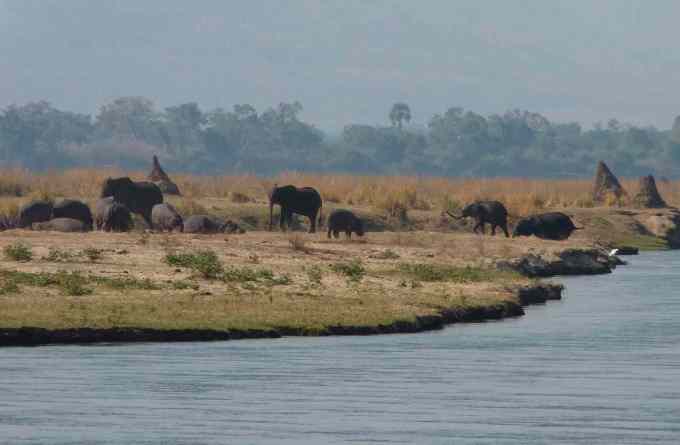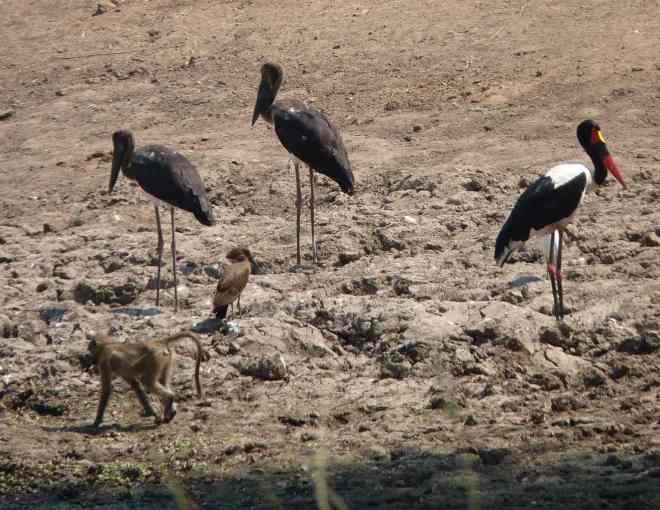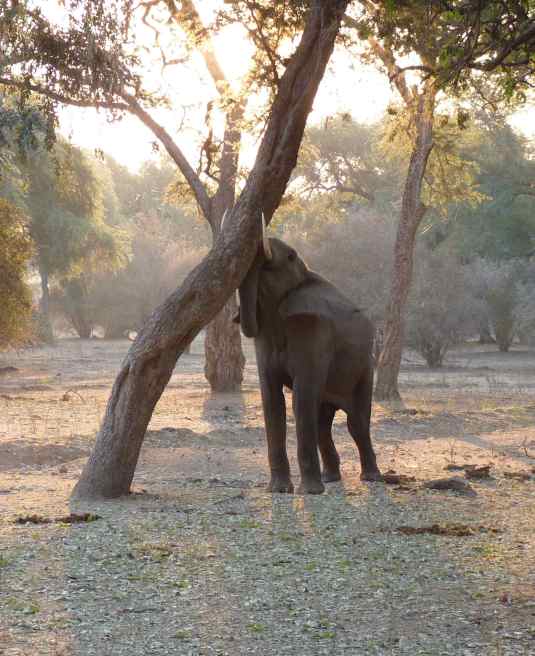We arrived at Mana Pools National Park (Mana Pools) at about 15:00 hours after a six hour drive from Harare. Just before the turn off to get into the final stretch of rough dirt road, we stopped at the edge of the escarpment to take in the hazy view of the Zambezi valley below, always a beautiful sight, and one that is full of anticipated adventure. The view was even hazier than usual, as this is the season of bush fires that add a blue tint to the horizon.
The stop to contemplate the view had to be brief as we still had about two hours of driving to get to the park. As soon as we started the escarpment’s steep descent we came across a queue of lorries parked on both sides of the road. The normal sightings involve slow moving lorries either struggling uphill or burning brakes downhill, so this kind of mass convergence was not normal. We drove through the narrow “lorry tunnel” very slowly, passing around 60 lorries before we came to the reason for the queue. An unfortunate driver had lost control of his truck while going downhill and crashed at full speed against a rocky bend. The accident was recent as the rescue of the occupants’ was taking place as we passed by. This was a stark reminder of the dangers associated with driving.
The turn off into the rough road leading to Mana Pools came as a relief after witnessing such a mishap. We drove on and, after 80 km of dirt road; we arrived at Mana Pools, a UNESCO World Heritage site of similar standing to the Great Barrier Reef, the Tower of London or Yellowstone National Park. The recent book “Mana Pools” by Gregg Robinson presents excellent pictures and describes the park in great detail. What more can I say not being a poet but rather a humble veterinarian!
Mana Pools is a place of unique natural beauty. The Zambezi River, with its hilly background, forms its northern border and the area to the South is a flat wooded expanse where earlier river meanderings have left a number of separate pools that give the park its name. This is where game abounds and, because of the nature of their habitat they can be spotted at a distance, similar to the East African parks.
In addition to its magnificent and ancient trees and its abundant wildlife, Mana Pools is -I believe- the only national park in Africa where you can leave your car and walk on your own despite there being dangerous animals at large. We know of two prides of lions and a pack of painted dogs that live in the area, not to mention numerous hyenas, several buffalo herds, many elephants, the occasional leopard, crocodiles and hippos, among others.
You may be surprised at this unusual and seemingly dangerous freedom but it works well due to a combination of animal tolerance and human caution. So, you are able to leave your metal cage and walk around freely! However, we must never forget that the animals we see around us are wild and as such, require the utmost respect and caution from us. Walking away from the protection of your car demands extreme prudence at all times, along with being aware of your surroundings, the direction of the wind, where you place your feet along with being able to read other important signs and, most importantly: to remember where you parked your vehicle!
The beauty of leaving your car.
We found lions on our first day, ten minutes after leaving our lodge! There were two: a young male and an adult female. They were just visible in the bush, near Chisasiko pool. We stopped the car and joined other people already there having their morning coffee while watching the lions, a rather unique experience! The opinions were divided on whether they had or would hunt. To us they looked alert as if looking for prey but it was difficult to guesstimate!
Lion paw marks on the dusty road before they entered the bush.
While the lion conversation was going on, a new vehicle arrived. It was a group of tourists with a professional guide in his late fifties, known to some of the people present. As usual, the excited crowd informed him of the lions’ location. What followed next was as unexpected as it was shocking! He, followed by his unknowing clients and another staff member with a gun, walked straight towards the lions, doing exactly what you must not do! What happened next was as predictable as it was unnecessary: the lions moved off! The group then turned back and left!
“He is after a fat tip from his clients” was my angry and rather loud comment and then I heard my wife’s lapidary “poor man, it is sad that at his age he has to do this to get some extra money!” The latter was followed by another remark from a lady in the group “he left it a bit late!” Anyway, seeing that the situation had been modified by human folly beyond immediate recovery, we pushed on with the idea of coming back later as we knew that, despite the interference, the lions would remain in the area.
However, finding lions only ten minutes into your safari changes the situation as you become somehow “dependent” on what they will do next! Afterwards, while driving you wonder if they are hunting, moving or whether other lions have joined them (which means you could miss something unique!). We also made a mental note of their proximity to our lodge!
During our stay we were rewarded by nice sightings of buffalo, eland, greater kudu, waterbuck and zebra among others. We also saw a trio of fish eagles engaged in a loud territorial dispute and a proud saddle bill stork mother with her two grown offspring, although no male was around.
The two young saddle bill storks (left) and their mother. A hamerkop and a baboon complete the picture.
We did see the lions a few more times in the general area of the Chisasiko pool, but they did not hunt and on the final day they moved off towards the mouth of the Mana river, probably stalking a buffalo herd that resides in that area. We also spotted a pair of Selous mongooses and two side striped jackals (Canis adustus). Our general impression was that the park has a good animal population.
We also attempted to visit a new water hole, recommended by a friend as a good place for a “sundowner”. Equipped with the right ingredients for such occasions, we drove following a path that was clearly a firebreak with the anticipation of reaching a quiet place where animals would come to drink. Unfortunately, after driving about 10 km we came to a wide sand river with very broken and steep banks. There were very recent and deep wheel marks in the sand showing that someone else had tried to find the waterhole and got severely trapped in the deep sand. The story was reinforced by the warm ashes of the campfire they had lit while spending the night by the car! We decided not to risk the crossing!
The river was a lovely place to have a drink anyway. We also enjoyed a nice walk on the dry riverbed framed by rather high cliffs made of red soil, where trumpeter hornbills feeding on wild figs could be seen. We will come back next time for another attempt at crossing the river.
Walking by the red cliffs in the sandy river
Elephants were numerous throughout the park. Young animals were in abundance. We also saw a number of adult tuskers. The latter do not carry heavy tusks of the type we saw in Kruger and described in my earlier post.
Although I will focus on the Mana trees in one of the next accounts, one tree is a major protagonist in Mana: the Apple-ring Acacia (Faidherbia albida). It is the main tree of the Mana riverine plain forest and it produces a spiral shaped pod eaten by most herbivores in the park and it constitutes a valuable source of food in the dry season.
The elephants are very fond of these pods and at this time of the year they can be seen feeding on them all the time, wherever the trees are. To watch this activity is rather engrossing so we stopped often to watch them as they pick them up from the floor using their trunks as vacuum cleaners! However, as usual, the best are difficult to get! The tastier pods are those still high up in the trees!
Pod collecting at full stretch.
Aware of this, elephants will go to great efforts to reach them and, with patience; you may be able to watch them doing it. This was, fortunately, our case as we came across several pod-eaters that stopped at nothing to get these treats!
During the second day of our stay we found a particular tusker that “agreed” to put on a show for us. He was dealing with a rather tall tree, so he stretched to the highest possible extent in order to reach the place in a wild circus-like act, and brought down branches full of pods. After finishing them and unable to get any more, he changed tactics by leaning his head against the tree trunk and proceeding to head-butt it vigorously, which provoked a “pod rain” that it subsequently picked up from the floor.
Shaking the tree.
As the tusker moved off in search of other tasty trees we also moved off, still looking for elephants. As we were driving slowly, we were overtaken by another vehicle that, we found parked by the road after a while. We stopped and asked its sole occupant if he had seen the lions. “Not today” he replied, “I have been here for three days and only saw them the first day” he added. We volunteered what we knew about the current lions’ location and asked “Any painted dogs*?” as we knew that these carnivores are often seen in Mana.
We could not believe his reply: “Do you mean other dogs apart from the one that we just saw crossing the road in front of your car?” “Are you serious?, we did not see anything!” my wife’s response came immediately. The reply came: “OK then, apart from the one I saw and you didn’t?” he said, clearly enjoying the moment and with a nice touch of humour. “We did not see it!” we confessed rather sheepishly, as it seemed unbelievable to us that this could have happened. He then added “I see them often as I am part of a painted dog conservation project that works here!”. Our embarrassment was somehow lessened as he had a “trained eye” for dogs!
Talking to him we learnt that the dogs are present in Mana around the “Mucheni” area and that the one he saw (and we didn’t!) was probably a male of a new pair that had just come from the Rukomechi area. We also learnt that the alpha male of the local Mana pack was missing and, although there could be several reasons for his absence, it is possible that it has died. We thanked him for the information but, despite it, we failed to see them during our safari. Our only consolation was that, although we did not see one, it was in the same place at the same time as us!!!
As a last attempt to save face, I tell you that we had seen painted dogs on a previous occasion in Mana Pools. We were on a game drive with my daughter/Editor when we spotted a pack on the road. There were about 16 dogs and they were moving rather fast. Taking advantage of the freedom of Mana Pools we parked the car in a hurry and followed them on foot, together with a group of tourists. It was very exciting as they caught an impala just before we got to them and they were feeding on it. Regrettably, the scene was interrupted by my loud talking -being a bushsnob- and the weird noise my camera made every time I switch it on! The picture below was taken at that time.
* Lycaon pictus is commonly referred to as African wild, cape or hunting dog and African painted dog, among other names. I use "Painted dogs" as this is the name used by the project in Zimbabwe.













This is so interesting!!
LikeLike